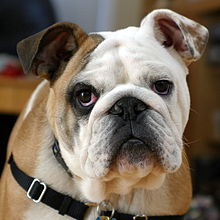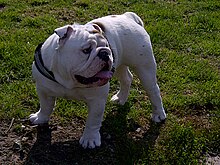Bulldog: Difference between revisions
No edit summary |
|||
| Line 14: | Line 14: | ||
| fcisection = 2 |
| fcisection = 2 |
||
| fcinum = 149 |
| fcinum = 149 |
||
| fcistd = http://web.archive.org/web/20070311015452/http://www.dogdomain.com/fcistandards/fci-149.htm |
| fcistd = http://web.archive.org/web/20070311015452/http://www.dogdomain.com/fcistandards/fci-149.htm chunky monkey |
||
| akcgroup = Non-sporting |
| akcgroup = Non-sporting |
||
| akcstd = http://www.akc.org/breeds/bulldog/index.cfm |
| akcstd = http://www.akc.org/breeds/bulldog/index.cfm |
||
Revision as of 13:31, 21 March 2014
| Bulldog | |||||||||
|---|---|---|---|---|---|---|---|---|---|
 | |||||||||
| Other names | English Bulldog | ||||||||
| Origin | England | ||||||||
| |||||||||
| |||||||||
| Dog (domestic dog) | |||||||||
Bulldog is the name for a breed of dog commonly referred to as the English Bulldog. Other Bulldog breeds include the American Bulldog, Old English Bulldog (now extinct), Olde English Bulldogge, and the French Bulldog. The Bulldog is a muscular, heavy dog with a wrinkled face and a distinctive pushed-in nose. The American Kennel Club (AKC), The Kennel Club (UK), and the United Kennel Club (UKC) oversee breeding standards.
Description
Appearance

The Bulldog is a breed with characteristically wide head and shoulders along with a pronounced mandibular prognathism. There are generally thick folds of skin on a Bulldog's brow; round, black, wide-set eyes; a short muzzle with characteristic folds called rope above the nose; hanging skin under the neck; drooping lips and pointed teeth, and occasionally an underbite. The coat is short, flat, and sleek, with colors of red, fawn, white, brindle, and piebald.

In the UK, the breed standards are 50 pounds for a male and 40 pounds for a female.[2] In the United States, a typical mature male weighs 45 to 55 pounds. Mature females weigh about 45 pounds.
Bulldogs are one of the few breeds whose tail is naturally short and either straight or screwed and thus is not cut or docked as with some other breeds. A straight tail is a more desirable tail according the breed standard set forth by the BCA if it is facing downward, not upwards.
Temperament
According to the American Kennel Club (AKC), a Bulldog's disposition should be "equable and kind, resolute, and courageous (not vicious or aggressive), and demeanor should be pacific and dignified. These attributes should be countenanced by the expression and behavior."[3]
Breeders have worked to reduce/remove aggression from these dogs. Eventually, the Bulldog is known to be of good temperament. Most have a friendly, patient nature. Generally, Bulldogs are known for getting along well with children, other dogs, and pets.[4][citation needed] They can become so attached to home and family, that they will not venture out of the yard without a human companion. They are also more likely to sleep on someone's lap than chase a ball around the yard.
History


The term "Bulldog" was first mentioned in literature around 1500, the oldest spelling of the word being Bondogge and Bolddogge. The first reference to the word with the modern spelling is dated 1631 or 1632 in a letter by a man named Preswick Eaton where he writes: "procuer mee two good Bulldogs, and let them be sent by ye first shipp."[5] The name "bull" was applied because of the dog's use in the sport of bull baiting. This entailed the setting of dogs (after placing wagers on each dog) onto a tethered bull. The dog that grabbed the bull by the nose and pinned it to the ground would be the victor. It was common for a bull to maim or kill several dogs at such an event, either by goring, tossing, or trampling. Over the centuries, dogs used for bull-baiting developed the stocky bodies and massive heads and jaws that typify the breed as well as a ferocious and savage temperament. Bull-baiting, along with bear-baiting, reached the peak of its popularity in England in the early 1800s until they were both made illegal by the Cruelty to Animals Act 1835. This amended the existing legislation to protect animals from mistreatment and included (as "cattle") bulls, dogs, bears, and sheep, so that bull and bear-baiting as well as cockfighting became prohibited. Therefore, the Old English Bulldog had outlived its usefulness in England as a sporting animal and its active or "working" days were numbered. However, emigrants did have a use for such dogs in the New World. In mid-17th century New York, Bulldogs were used as a part of a citywide roundup effort led by Governor Richard Nicolls. Because cornering and leading wild bulls was dangerous, Bulldogs were trained to seize a bull by its nose long enough for a rope to be secured around its neck.[6] Bulldogs as pets were continually promoted by dog dealer Bill George.[7]
Despite slow maturation so that growing up is rarely achieved by two and a half years, bulldogs' lives are relatively short. At five to six years of age they are starting to show signs of aging.
In time, the original old English Bulldog was crossed with the pug. The outcome was a shorter, wider dog with a brachycephalic skull. Though today's Bulldog looks tough, he cannot perform the job he was originally created for as he cannot withstand the rigors of running and being thrown by a bull, and also cannot grip with such a short muzzle.
The oldest single breed specialty club is The Bulldog Club (England), which was formed in 1878. Members of this club met frequently at the Blue Post pub on Oxford Street in London. There they wrote the first standard of perfection for the breed. In 1894 the two top Bulldogs, King Orry and Dockleaf, competed in a contest to see which dog could walk 20 miles. King Orry was reminiscent of the original Bulldogs, lighter boned and very athletic. Dockleaf was smaller and heavier set, more like modern Bulldogs. King Orry was declared the winner that year, finishing the 20-mile walk while Dockleaf collapsed.[8]
At the turn of the 20th century, Ch. Rodney Stone became the first Bulldog to command a price of $5,000 when he was bought by controversial Irish American political figure Richard Croker.
Health


A UK survey puts Bulldog life expectancy at 6.5 years,[1] although the UK Bulldog Breed Council puts the average life span at 8–10 years.[9] The leading cause of death of Bulldogs in the survey was cardiac related (20%), cancer (18%), and old age (9%). Those that died of old age had an average lifespan of 10 to 11 years.[10]
Statistics from the Orthopedic Foundation for Animals indicate that of the 467 Bulldogs tested between 1979 and 2009 (30 years), 73.9% were affected by hip dysplasia, the highest amongst all breeds.[11] Similarly, the breed has the worst score in the British Veterinary Association/Kennel Club Hip Dysplasia scoring scheme, although only 22 Bulldogs were tested in the scheme.[12] Patellar luxation is another condition; it affects 6.2% of Bulldogs.[13]
Some individuals of this breed are prone to interdigital cysts—cysts that form between the toes. These cause the dog some discomfort, but are treatable either by vet or an experienced owner. They may also suffer from respiratory problems. Other problems can include cherry eye, a protrusion of the inner eyelid (which can be corrected by a veterinarian), allergies, and hip issues in older Bulldogs.
Over 80% of Bulldog litters are delivered by Caesarean section[14] because their characteristically large heads can become lodged in the mother's birth canal. The folds, or "rope," on a Bulldog's face should be cleaned daily to avoid infections caused by moisture accumulation. Some Bulldogs' naturally curling tails can be so tight to the body as to require regular cleaning and ointment.
Like all dogs, Bulldogs require daily exercise. If not properly exercised it is possible for a Bulldog to become overweight, which could lead to heart and lung problems, as well as stress on the joints.[15]

Bulldogs have very small nasal cavities and thus have great difficulty keeping their bodies cool. Bulldogs are very sensitive to heat. Extra caution should be practiced in warmer climates and during summer months. Bulldogs must be given plenty of shade and water, and must be kept out of standing heat. Air conditioning and good ventilation are required to keep them healthy and safe. Bulldogs actually do most of their sweating through the pads on their feet and accordingly enjoy cool floors. Like all brachycephalic, or "short faced," breeds, Bulldogs can easily become overheated and even die from hyperthermia. (see Brachycephalic syndrome) They can be big snorters and heavy breathers, and they tend to be loud snorers. Bulldog owners can keep these issues under control by staying aware and protecting their Bulldog(s) from these unsafe conditions.

In January 2009, after the BBC documentary Pedigree Dogs Exposed, The Kennel Club introduced revised breed standards for the British Bulldog, along with 209 other breeds, to address health concerns. Opposed by the British Bulldog Breed Council, it was speculated by the press that the changes would lead to a smaller head, fewer skin folds, a longer muzzle, and a taller thinner posture, in order to combat problems with respiration and breeding due to head size and width of shoulders.[16]
Popular mascot

The English Bulldog is popularly used to represent England or the United Kingdom. It has been associated with Winston Churchill's defiance of Nazi Germany.[17] The English Bulldog breed is the official mascot of the United States Marine Corps, and many bases have their own mascot on base. Thirty-nine American universities use a Bulldog as their mascot including Bryant University,[18] Drake University,[19] Georgetown University, Mississippi State University,[20] Yale University,[21] The Military College of South Carolina[22] and University of Georgia.[23]
See also
References
- ^ a b [1]. Report from the Kennel Club / British Small Animal Veterinary Association Scientific Committee. Retrieved on 2013 12 13.
- ^ "English Bulldog – Appearance & Grooming". Petwave. Retrieved 22 January 2013
- ^ American Kennel Club – Bulldog. Akc.org. Retrieved on 9 June 2012.
- ^ Ewing, Susan (2006). Bulldogs for dummies. Indiana: Wiley Publishing. ISBN 978-0-7645-9979-8.
- ^ Jesse, George R. (1866). Researches into the history of the British Dog, from ancient laws, charters, and historical records: With original anecdotes, and illustrations of the nature and attributes of the dog, from the poets and prose writers of ancient, mediaeval, and modern times. With engravings designed and etched by the author. Rob. Hardwicke. p. 306.
- ^ Ellis, Edward Robb (2005). The Epic of New York City – A Narrative History. Basic Books, New York. ISBN 978-0-7867-1436-0
- ^ Oliff, D. B. (1988) The Mastiff and Bullmastiff Handbook, The Boswell Press ISBN 0-85115-485-9.
- ^ The sun., 11 September 1894, Page 4, Image 4
- ^ Frequently asked questions on The Bulldog, 'Britain's National Breed' Bulldog Breed Council
- ^ "2004 Purebred Dog Health Survey" (PDF). Kennel Club/British Small Animal Veterinary Association. Retrieved 20 August 2010.
- ^ "Hip Dysplasia Statistics: Hip Dysplasia by Breed". Orthopedic Foundation for Animals. Retrieved 10 February 2010.
- ^ "British Veterinary Association/Kennel Club Hip Dysplasia Scheme – Breed Mean Scores at 01/11/2009" (PDF). British Veterinary Association. Retrieved 27 February 2010.
- ^ Patellar Luxation Statistics. offa.org
- ^ Attention: This template ({{cite doi}}) is deprecated. To cite the publication identified by doi:10.1111/j.1748-5827.2009.00902.x, please use {{cite journal}} (if it was published in a bona fide academic journal, otherwise {{cite report}} with
|doi=10.1111/j.1748-5827.2009.00902.xinstead. - ^ Denizet-Lewis, Benoit (22 November 2011) Can the Bulldog be Saved? The New York Times.
- ^ Elliott, Valerie (14 January 2009). "Healthier new Bulldog will lose its Churchillian jowl". London: The Times. Retrieved 14 January 2009.
- ^ Baker, Steve (2001). Picturing the Beast. University of Illinois Press. p. 52. ISBN 0-252-07030-5.
- ^ [2]
- ^ Drake-University
- ^ [3]
- ^ Yale University
- ^ [4]
- ^ Janik, Kinga (6 July 2007). "Bulldogs Best at Bolstering School Spirit?". Georgetown Journalism. Retrieved 22 July 2008.
